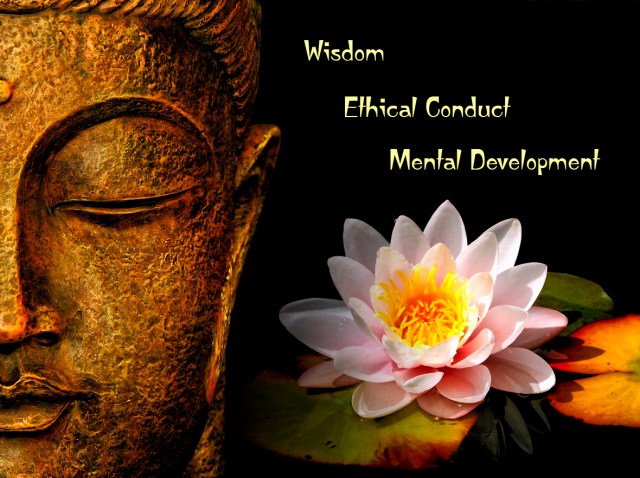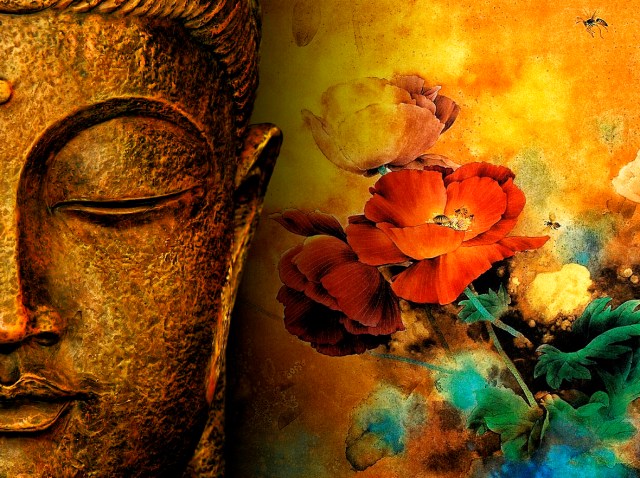In my first article on Buddhism, we examined the Four Immeasurable Minds. These may be best described as highly elevated spiritual states of mind or ways of being. The Noble Eightfold Path discussed here can be thought of as a practical guide for living a noble and virtuous life.
The two are interrelated and interactive. Progress toward one fosters progress in the other. When both are present in an individual, the person is not only truly enlightened, but they serve as a role model for those wishing to achieve the highest levels of spirituality.
Some may worry that the Four Immeasurables may be too much of a paradigm shift to achieve or consistently sustain in a world culture that seems to be diametrically opposed to them. Such a shift in one’s state of mind is indeed challenging, but it is a goal well worth pursuing.
The Noble Eightfold Path gives us practical goals for how we should strive to live our everyday lives in a manner that leads to spiritual awakening and liberation from a mind-set of greed, hatred, violence, duplicity, and self-aggrandizement. It is a path that can transform us spiritually and prepare us for progression to the divine state of the Four Immeasurable Minds.
The Noble Eightfold Path
The word “right” in this context means “in the right and most beneficial or positive way.”
1. Right View or Understanding.
Right view is seeing and understanding things clearly as they truly are. It is also the ability to distinguish between thoughts and actions that are wholesome or unwholesome. Right view requires a flexible, open mind. It leads to an understanding of the law of cause and effect or moral law of karma; namely, that any action will produce results or effects that have the same nature as the action.
2. Right Thinking, Thought, or Intention.
We need to free our minds from bias, prejudice, wrong perceptions, making assumptions, and judging. Through right thought one makes an effort to rid one’s self from what they know to be wrong or immoral. In so doing, we are making a commitment to follow a spiritual path. Right thinking leads to right speech and right action.
3. Right Speech.
Do not lie, bear false witness, use harsh, hateful, or divisive language, gossip, be rude, engage in useless chatter, etc. Always speak truthfully and lovingly in a manner that brings joy, hope, and understanding to others. Our speech should be guided by right view and right thinking.
4. Right Action or Conduct.
Engage in moral, ethical, honorable, and peaceful action. Practice nonviolence and be committed to protecting all life on earth.
5. Right Livelihood.
Choose a profession that is honorable, ethical, and helps and sustains living things rather than one that supports war, killing, disharmony, or harms, cheats, or exploits them. Five types of livelihoods to be avoided are specifically mentioned:
Trade in any kind of weapons.
Any form of trade in human beings.
Breeding and selling of animals for slaughter.
Manufacture or sale of addictive drugs or intoxicating drinks.
Production or trade of any kind of toxic substance or poison designed to harm living things.
6. Right Effort or Diligence. (Paraphrased from Rahula referenced below)
Right diligence is a concerted effort (1) to prevent evil and unwholesome states of mind from arising, (2) to rid one’s self from such thoughts that have already arisen (3) to produce good and wholesome states of mind that have not yet arisen, and (4) to develop and bring to perfection the good and wholesome states of mind already present.
7. Right Mindfulness.
Right mindfulness is being diligently aware of activities of the body, our sensations and feelings, and our thoughts (and their nature). It is being mindful of and living in the present moment free from all thoughts or concern about the past or the future. In mindfulness we refrain from judgement or interpretation of what we are experiencing in the moment. When we are mindful, right thinking, right speech, right action, etc. will be expressed.
8. Right Concentration.
Buddha said that when we have a singleness of mind supported by the other seven factors of the Noble Eightfold Path we have achieved right concentration. It is an essential component of effective meditation.
Right concentration is described as a one-pointed mind. That is, the ability to focus or concentrate on one thing. Right concentration encompasses and is facilitated and supported by the other seven elements of the Noble Path. The practice of right concentration allows us to cultivate insight and develop wisdom by examination of the true nature of things through meditation.
It is by striving to follow the Noble Eightfold Path in our everyday life that we develop the basic principles of ethical conduct, mental discipline, and wisdom which are central to Buddhist practice. Buddha gave many discourses on each element of the Path to explain their meaning in great depth. Consequently, my brief explanations are sorely incomplete and do not give a full appreciation of the scope and quality of each element of the Path.
While many components of the Eightfold Path are things for which most people seeking a spiritual way of life would strive, the Path codifies a stepwise process to achieve them. The Noble Eightfold Path encompasses universal elements of a spiritual way of life. Many of them resonate with the teachings of Christianity and other religions.
I would place persons who engage in spiritual practices and thought akin to those of Buddhists among the exalted meek who are said to one day inherit the earth. In a world seemingly filled with murky shadows and darkness, they are a beacon of light and hope.
References
Hanh, Thich Nhat, The Heart of the Buddha’s Teaching. Transforming Suffering into Peace, Joy, and Liberation. New York: Harmony Books. 2010. First published 1999.
Rahula, Walpola. What the Buddha Taught. 2nd ed. enlarg. New York: Grove Press. 1974. First published 1959.
You might like to see the following related articles:


You must be logged in to post a comment.